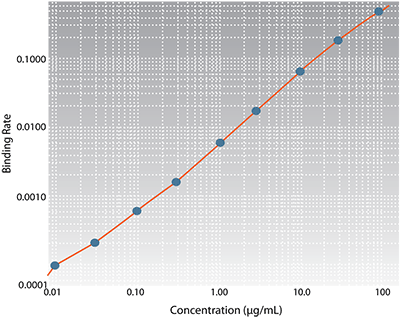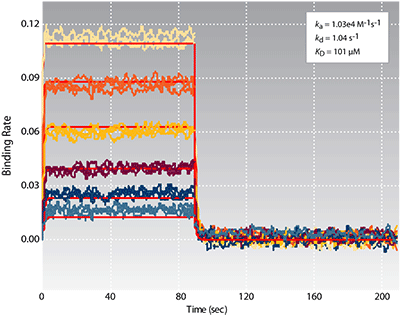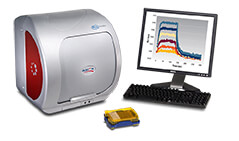The Octet RED96 system is ideally suited for 96-well characterization of protein-protein and protein-small molecule binding kinetics, and for the determination of protein concentrations and titer. Popular industrial applications include expression screening, on- and off-rate screening, epitope binning, cell line development and bioprocess optimization. The Octet RED96 system is widely used in analytical core labs for protein structure/function studies and small molecule screening campaigns.
Key Benefits
- Large Quantitation Dynamic Range
The Octet RED96 system provides an unprecedented dynamic range from ng/mL to mg/mL for quantitation of biomolecules – 25 ng/mL to 2000 µg/mL of human IgG using Protein A biosensors. - Versatile Kinetic Analysis
Accurate kinetic analyses of large macromolecules such as IgG to small molecule fragments of 150 Da are possible on the Octet RED96 system. - 8-Channel Throughput
The Octet RED96 system uses disposable biosensors in an 8x12 array in a simple, Dip and Read™ label-free assay format to measure the titer of 96 samples in 30 minutes. - Low Operational Costs
Combined with biosensor regeneration, Octet RED96's re-racking option provides ultra-low cost per test for direct binding concentration measurements and kinetic analyses.
Concentration Analysis
Measure concentrations of native proteins and other biomolecules by direct binding from solutions in a 96-well microplate in a simple, one-step Dip and Read assay. A large dynamic range for direct binding from ng/mL to mg/mL combined with 8-well simultaneous read-out gives you results in 32 minutes for 96 samples. Run high sensitivity sandwich ELISA and other ligand binding immunoassays on the Octet system in just an hour or two!

Figure 1: Calibration curve for human IgG (hIgG) binding to Protein A biosensors obtained over 300 seconds at a shake speed of 1000 rpm. Shaking at 200 rpm for 120 seconds allows quantitation of 0.5–2000 µg/mL of hIgG.
Kinetic Analysis
Octet RED96 provides reliable kinetic parameters information including ka, kd and KD for protein-biomolecule interactions and protein-small molecule interactions. Perform crude antibody screening and epitope binning and mapping for rapid development of biopharmaceutical drugs, or screen more than 400 compounds in a small molecule and fragment library in 8 hours. Follow up the screen with accurate kinetic characterization of your drug candidates on the same system.

Figure 2: Example data of Sulpiride (MW 341 Da) binding to carbonic anhydrase II loaded on Super Streptavidin biosensors. Binding was performed in the presence of 0.5% DMSO at a shake speed of 1000 rpm. Triplicate measurements were performed at each concentration in a 2-fold dilution series.
Literature References
References to ForteBio's products in published literature.
